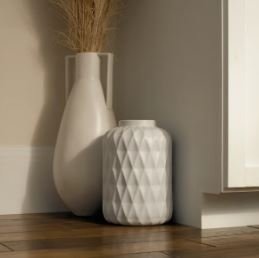What is Light Reflectance Value (LRV)?
Simply put, light can dramatically change the way you read colours in your home. Light reflectance value (LRV) is a measure of visible and usable light reflected from a surface when it is hit with light. Every colour has it’s own light reflectance value and that value can make or break whether a colour provides the look and feel you were after or not.
Both natural and artificial light will affect the way your colours read, and these can also change dramatically throughout the day. For example, first thing in the morning, you may have a kitchen that receives a ton of natural light from an east facing window and doesn’t require the use of any artifical lighting. Later in the day it may need all artificial lighting to be able to use the space. The colours used in that kitchen will look very different as the day and night progress.
Although we cannot change the colour of the natural daylight that enters our homes, we do have a lot of say in the type of artificial lighting we use. Where there used to be only one option, the good old 2700K incandescent bulb, there are a vast array of types of bulbs with options in shape, style and most importantly colour.
Almost all of our clients are moving towards the complete use of LED bulbs, which makes the most sense if you are wanting to get the most longevity out of your bulbs. Depending on where you are doing your bulb shopping, you will find an array of choices and it can be a bit overwhelming. Understanding a few key factors will help make it a bit easier.
If you love those warm autumn colours - rich reds, oranges and deep browns, then you may want to go with a warm white bulb with kelvin temperature of 2700K. This has been the go to bulb colour for decades and best imitates a candle flame colour. It has become less popular over the past few years, but still is a good choice for the right space.
2700 Kelvin Temperature
I work with a lot of clients who love the use of blues, greens and whites in their decor. So, this next lamp colour (3000-3500K)works beautifully with that colour palette and feels most like lovely morning light. I haven’t found a space that this colour temperature didn’t work for, so if you are unsure, this might be a good place to land.
3000 Kelvin Temperature
What I find many of my clients are nervous about when I suggest upping the temperatures on their lighting is that we are going to end up here - at the 5000K or higher. When you start to get into this number range, it will feel cool and blue. There are spaces this is right for, but rarely in a residential home setting.
5000K Kelvin Temperature
Looking back at each of those photos, the paint colour on the walls is the same, but it reads entirely different due to the lighting.
So let’s get back to the light reflectance value (LRV). Now that we have discussed what we can and cannot control from a lighting perspective, how can we use that information to select the right colours for our homes?
Each paint colour will have a light reflectance value. This number refers to how much light that colour will reflect back when hit with light and also how much it will absorb. Some manufacturers make it easy to find either on their paint swatches or on their websites, and some you may need to email to get the information. Typically, the lighter the colour, the higher the light reflectance value (LRV) and the lower the number, the more light that colour will absorb. The LRV does not change, no matter how much lighting you add to your space.
I had an experience of this first hand years ago on a renovation project I was working on. We had selected a medium - dark brown colour for a boys bathroom. Now this bathroom had a north facing window, a fixture in the centre of the ceiling and another fixture over the vanity. I made sure to select fixtures with high lumen (light) output to make up for the dark paint colour. Ya me! But, low and behold, as the fixtures were installed at the last stage of finishing the room was dark. My client called me and we decided we had better change out the fixture above the vanity - one with EVEN more lumen output. We did that two more times, and every time that room still felt too dark. I could not understand it! I ran the lumen numbers over and over and finally my client gave up and said it would do.
Knowing what I know now, the very first thing we needed to do, was change that paint colour and select one with a higher light reflectance value. That will never happen again on one of my jobs, but it shows the importance and the confusion that can be had.



